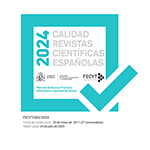El clero de Nueva España y las congregaciones de indios: de la evangelización inicial al III Concilio Provincial mexicano de 1585
Resumo
En el presente trabajo se estudian las discusiones y propuestas de religiosos y clérigos de Nueva España sobre el problema de la dispersión territorial de la población indígena, las cuales respondían a los dos proyectos de evangelización en pugna: el de los religiosos y el de los obispos. Cada sector eclesiástico tuvo su propio concepto de lo que debían ser las congregaciones y las metas que debían cumplirse con ellas. En el único decreto que los obispos dedicaron a las congregaciones en el tercer concilio provincial mexicano de 1585 se omitió cualquier reconocimiento a la obra de los frailes en las décadas anteriores; por el contrario, los jerarcas de la Iglesia diocesana reclamaron a los virreyes la falta de cumplimiento de las cédulas reales sobre reducciones. No obstante, el modelo practicado por los frailes en las congregaciones de mediados del siglo XVI fue el que se impuso al final.Downloads
##submission.format##
Licença
La Revista Complutense de Historia de América, para fomentar el intercambio global del conocimiento, facilita el acceso sin restricciones a sus contenidos desde el momento de su publicación en la presente edición electrónica, y por eso es una revista de acceso abierto. Los originales publicados en esta revista son propiedad de la Universidad Complutense de Madrid y es obligatorio citar su procedencia en cualquier reproducción total o parcial. Todos los contenidos se distribuyen bajo una licencia de uso y distribución Creative Commons Reconocimiento 4.0 (CC BY 4.0). Esta circunstancia ha de hacerse constar expresamente de esta forma cuando sea necesario. Puede consultar la versión informativa y el texto legal de la licencia.











